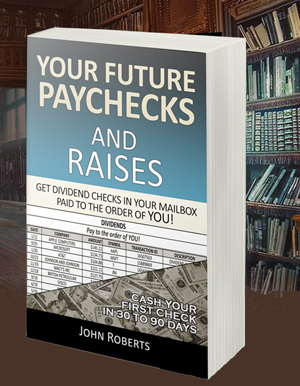How To Let Stock Profits Run And Limit Your Losses
Here’s the smart way to let your stock profits run and limit your losses. I like this method because often, even when your stock has gone down, you cash out at a profit.
That has a nice sound to it, yes?
So let’s check it out. This technique is called trailing stop losses, and it is what I use.
Here’s how it works. Instead of just deciding we will sell our stock if it goes down 25% from where we bought it, we are going to do something smarter than that.
Whenever the stock goes up higher, we are going to say we will sell it if it goes down 25% from that higher price. So if we bought some shares at $1000, if the stock went down to $750 the next day, we would sell them.
But if the shares went up to $2000, we just made $1000. It’s not smart wait until it goes back down to our original $750 stop loss now.
We set our standards higher. We make our new stop loss 25% from the highest price we’ve owned it at — $2000. Now we say we will sell the stock if it goes down to $1500.
So in that case, even if the stock goes down 25% from our new stop limit, we sell at a profit. Because we bought the shares at $1000 and we sold them at $1500.
Nice.
If you have just a few stocks you can track and calculate your trailing stop losses manually. You simply keep track of the highest price each stock gets to by writing down the date and price when one of your stocks makes a new high. Then you multiply that by .75 which gives you your new stop loss. Write that down. If your stock goes below that new stop loss price you should sell it.
You have to look at this every day for it to work.
Also, you may have wondered why I said multiply the new high price by .75 to get your new trailing stop loss. This is just a shortcut to calculating your new 25% stop loss. For example, if your stock hit a new high of $40 today, you can calculate 25% of it ($40 X .25) which is $10. Then you subtract the $10 from the new high of $40 which gives you your new stop loss of $30.
Or you can just multiply the $40 by .75 which will give you the new stop loss of $30 in one step. It’s the same thing, so we do it the easy way.
There are two other ways to do this with much less work. One of them costs a little bit and the other is free (but not as good).
I use a software service called Tradestops to keep track of all of this for me. So whenever I buy a stock, I go to my www.tradestops.com account and enter in the new stock, the price I bought it for, and 25% for the trailing stop percent.
Tradestops automatically checks each of my stocks prices every day and moves the trailing top up automatically when they hit a new high price. Then, if my stock goes down 25% below the highest price, it sends me an email alert, and I go to my account and sell the stock.
This is by far the best way to do this. The service costs $9.95 a month, but it is well worth it.
The other way, which is free, is to use this same feature in your trading account. You can put in a “Good Til Canceled” order to sell your stock automatically any time it goes below your 25% trailing stop in the next six month. This is called a stop loss order.
There are two disadvantages to this.
The greatest disadvantage is that the people on the exchanges can see what price you are willing to sell your stock at. With this insider knowledge, in some circumstances, they might be able to manipulate the market price down to your stop loss price temporarily, sell your stock, buy it cheap and then move the market price back up.
If this sounds like cheating – it is. Even though the market is highly regulated and most of the people in the industry are honest, there are always a few bad apples in the bunch. Also, I have no direct proof of this but a number of credible financial writers warn against it.
I think this happens pretty rarely, so your risk is low. But in all my years of trading, I think I have had it happen to me twice. I can’t prove that. But the two stocks I am thinking of seemed to move mysteriously down to my stop loss price, get sold, and then quickly pop right back up.
That could have been normal market action … and then again, maybe not.
When I was a stockbroker, I would routinely enter stop loss orders for clients if they requested it, so it is considered a normal practice by the industry and used frequently. But I thought I’d clue you in on the potential risk.
The other disadvantage is when the stop loss triggers and your stock gets sold. Many experts recommend checking the stock against the stop loss at the end of the trading day, and only then deciding if you will sell it the next day.
This is because the markets may start out high in the morning, move down during the day, then toward the end of the day when the market is about to close, start moving back up. With a stop loss order, you might see your stock get sold at the very bottom during the day, only to watch the price go back up above your stop loss at the end of the day.
So that is a valid consideration.
However, I have found that there is one great advantage to using trailing stop loss orders that automatically sell. That advantage is discipline.
If you feel you just don’t have the discipline to sell when you should, that you will just watch your stock go down and hang on to it, hoping, wishing and praying it will go back up instead of selling it like you should, these stop loss orders will do it for you.
On rare and special occasions (beyond the scope of this book) I will use this feature even today because it lets me set up the entire trade beforehand and walk away. I know that if the market hits my predetermined stop, it will just execute my order and be done with it.
The choice is yours. But in general I favor checking at the end of the day and using the Tradestops service to just alert me.
I describe more about other ways to limit your losses in my book Stock Market For Beginners. So if you’d like to learn more money making tips, or you’re just getting into stock investing, or would like to learn at a simple to understand stocks 101 / stocks for dummies level, then just click here to learn more – Learn About Stock Market For Beginners.
To your health and prosperity – John



